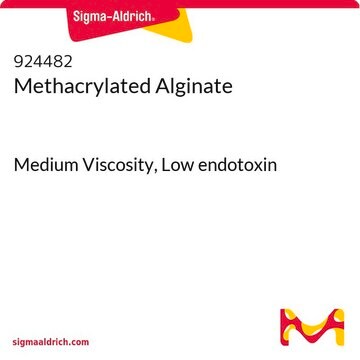Only the aldehyde content is determined by the titration with hydroxylamine. The location of the aldehyde groups is not determined and the image is representative.
923850
Alginate Aldehyde
20% aldehyde content, medium viscosity
Sinonimo/i:
Alginate aldehyde, Oxidized alginate
Scegli un formato
About This Item
Prodotti consigliati
Livello qualitativo
Descrizione
Degree of functionalization: 15-25%
Stato
powder
Colore
white to off-white
Compatibilità
conforms to structure for NMR
Temperatura di conservazione
2-8°C
Stringa SMILE
CO[C@H]1[C@@H](O)[C@H](O)[C@H](O/C(C=O)=C\C([O-])=O)O[C@@H]1C([O-])=O.OC2[C@H](OC(O)C=O)[C@@H](C([O-])=O)O[C@@H](OC)[C@H]2O
Cerchi prodotti simili? Visita Guida al confronto tra prodotti
Applicazioni
Alginate is commonly crosslinked into a hydrogel via ionic-crosslinking with divalent cations (e.g., Ca2+). To prevent matrix degradation, alginate can be functionalized with reactive groups that can be chemically crosslinked, such as aldehydes.[5] Aldehyde- functionalized alginate can be used to prepare hydrogels by reaction with amine groups, such as gelatin through Schiff-base reaction to form a chemical hydrogel. This material can be used in a variety of biomedical applications such as the delivery of drugs, cells, or biomolecules in different tissues, wound healing, and muscle and bone tissue engineering. [6]
Codice della classe di stoccaggio
11 - Combustible Solids
Classe di pericolosità dell'acqua (WGK)
WGK 3
Punto d’infiammabilità (°F)
Not applicable
Punto d’infiammabilità (°C)
Not applicable
Scegli una delle versioni più recenti:
Certificati d'analisi (COA)
Non trovi la versione di tuo interesse?
Se hai bisogno di una versione specifica, puoi cercare il certificato tramite il numero di lotto.
Possiedi già questo prodotto?
I documenti relativi ai prodotti acquistati recentemente sono disponibili nell’Archivio dei documenti.
-
Is the alginate aldehyde terminated, as described in the linear formula, with only 20% of the chains functionalized? Or is the backbone of the chain functionalized with aldehyde with 20% of the monomers containing aldehyde groups?
1 answer-
Helpful?
-
Active Filters
Il team dei nostri ricercatori vanta grande esperienza in tutte le aree della ricerca quali Life Science, scienza dei materiali, sintesi chimica, cromatografia, discipline analitiche, ecc..
Contatta l'Assistenza Tecnica.








